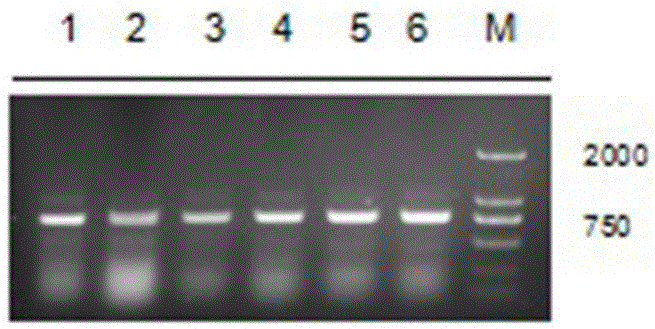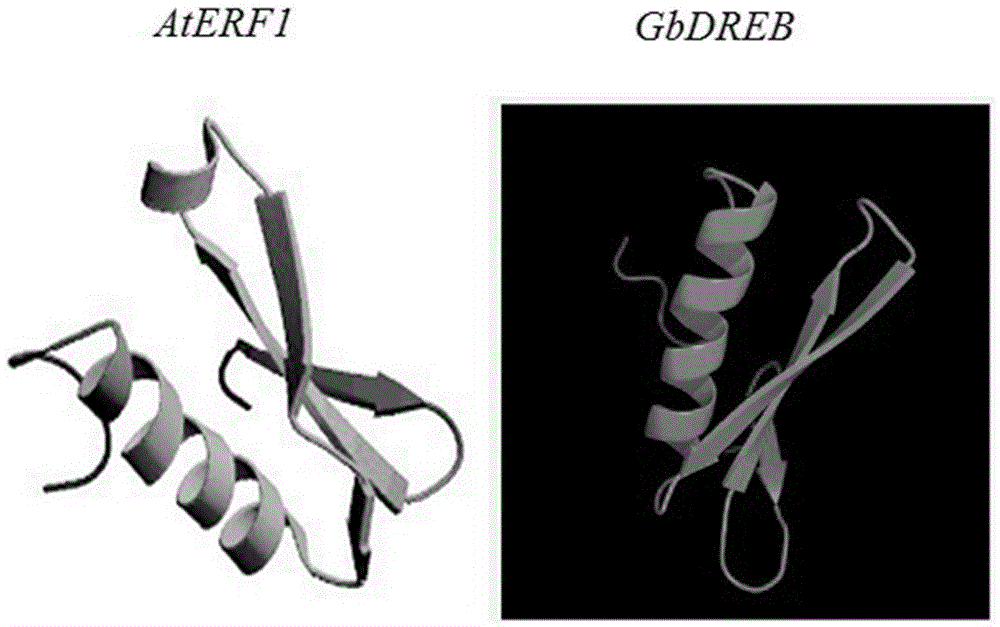Application of cotton GbDREB gene in resisting verticillium wilt
A technology for resistance to Verticillium wilt and Verticillium wilt, applied in application, genetic engineering, plant genetic improvement and other directions, can solve problems such as changes and few reports of disease resistance
- Summary
- Abstract
- Description
- Claims
- Application Information
AI Technical Summary
Problems solved by technology
Method used
Image
Examples
Embodiment 1
[0041] Based on previous studies, the inventors found that after being infected by Verticillium wilt, cotton GbDREB Significant changes have taken place in gene expression, therefore, the inventors based on sea island cotton (Xinhai 15) to GbDREB Genes were analyzed in detail, and the specific process is briefly described below.
[0042] 1. Sea Island cotton GbDREB Gene acquisition
[0043] First, plant cotton, extract the RNA of cotton seedlings, and perform reverse transcription to obtain cDNA;
[0044] For the RNA extraction steps, refer to the EASYspin Plus Plant RNA Rapid Extraction Kit, and the reverse transcription steps are as follows:
[0045] Total RNA, 1000 / RNA concentration;
[0046] Oligo dT18 (10 μM), 1 μL;
[0047] Random primers, 1 μL;
[0048] wxya 2 O (RNase-free) made up to 13 μL;
[0049] In a PCR machine, run at 65°C for 5 minutes, and quickly put it on ice for 2 minutes;
[0050] Add the following reagents to the above reaction system:
[0051] ...
Embodiment 2
[0091] In the aforementioned Example 1, for the gene GbDREBBased on the understanding of the basic characteristics, the inventors further analyzed the tissue expression pattern of this gene in cotton tissue under natural conditions and the tissue expression after stress. The relevant experiments are briefly introduced as follows.
[0092] 1. Natural (wild-type) genes GbDREB tissue expression pattern
[0093] The root, stem, and leaf tissues of Xinhai 15 were collected separately, RNA was extracted, and cDNA was obtained using a reverse transcription kit, and the following quantitative PCR primers were used for qPCR amplification:
[0094] QRT-PCR-GbDREBF: 5'-CTACAGGAGAGTATGTGGATGAGGATG-3',
[0095] QRT-PCR-GbDREBR: 5'-CGTCGTCATCGGAAGGTATCAAG-3';
[0096] Ubiquitin 7 (UB7) was selected as an internal reference gene, and the primer sequences were designed as follows:
[0097] UBQ7F: 5'-GAAGGCATTCCACCTGACCAAC-3',
[0098] UBQ7R: 5'-CTTGACCTTTCTTCTTCTTGTGCTTG-3';
[0099] qR...
Embodiment 3
[0125] Further, the inventors used VIGS technology to construct a VIGS interference vector to gene GbDREB Conduct silence. After observing the phenotypic changes of cotton against Verticillium dahliae infection after gene silencing, the results further proved that the gene GbDREB It is highly related to Verticillium wilt resistance, and the related experiments are briefly introduced as follows.
[0126] (1) Construction of VIGS interference carrier
[0127] in gene GbDREB Design primers for non-conserved segments:
[0128] F: 5'-GCGGATCCATTTTTCTAATAATGCTGCTGTAAG-3',
[0129] R: 5'-GGGGTACCGCTGCAACTTAATACCACCAAT-3';
[0130] The principle of primer design is: add an enzyme to the upstream primer Kpn Restriction site and protective base of I, add enzyme to downstream primer Bam Restriction sites and protective bases of HI;
[0131] PCR amplified target sequence (about 200 bp);
[0132] Then, after recovering the PCR amplification product and the empty vector pTRV2, u...
PUM
 Login to View More
Login to View More Abstract
Description
Claims
Application Information
 Login to View More
Login to View More - R&D
- Intellectual Property
- Life Sciences
- Materials
- Tech Scout
- Unparalleled Data Quality
- Higher Quality Content
- 60% Fewer Hallucinations
Browse by: Latest US Patents, China's latest patents, Technical Efficacy Thesaurus, Application Domain, Technology Topic, Popular Technical Reports.
© 2025 PatSnap. All rights reserved.Legal|Privacy policy|Modern Slavery Act Transparency Statement|Sitemap|About US| Contact US: help@patsnap.com



